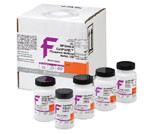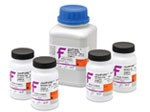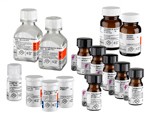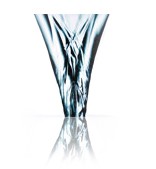Browse All Restriction Enzymes & Buffers
Purity: OPTIZYME restriction enzymes are produced using high-yielding expression vectors, resulting in a higher level of purity and lower processing time than native restriction enzymes.
Consistency: OPTIZYME restriction enzymes are manufactured in class D clean rooms using recombinant production techniques to yield large lot sizes. The combination of leading production technology with ISO9001 quality and ISO14001 environmental management systems ensures high digestion and ligation efficiency, as well as batch-to-batch reproducibility.
Value Pricing: The use of high-yielding expression vectors and bacterial strains enables Fisher BioReagents to offer recombinant enzymes with the lowest price/unit charges, allowing our customers to benefit from both substantial savings and improved consistency and quality.

OPTIZYME DNA/RNA Modifying Enzymes are manufactured using high yielding expression vectors in class D clean rooms under strict ISO9001 quality and ISO14001 environmental management systems. By combining leading recombinant production technology with value pricing and batch-to-batch consistency, OPTIZYME customers benefit from both substantial savings and improved quality and consistency on modifying enzymes used for:
More
Genomics applications, such as gene cloning and DNA genotyping, require high-quality restriction enzymes. The Fisher BioReagents OPTIZYME line of restriction enzymes offers customers an outstanding combination of quality, performance and low prices.
More
The purpose of a buffer in a biological system is to maintain intracellular and extracellular pH within the physiological range and resist changes in pH due to the presence of internal and external influences. CellPURE Biological Buffers from Fisher BioReagents are ultrapure zwitterionic buffers that possess both positive and negative charges. First described by Norman Good and co-workers in 1966, these organic buffers have pKa values at or near physiological pH and minimal interference with biological processes. CellPURE Biological Buffers are ideal for cell cultivation, isolation of cells, enzyme assays and other biochemical applications.
More| Description | Formula | Molecular Weight | pKa @ 25º C | Useful pH Range |
|---|---|---|---|---|
C₈H₁₉NO₅ | 209.24 | 6.5 | 5.8 to 7.2 | |
C₁₁H₂₆N₂O₆ | 282.33 | 6.8† | 6.3 to 9.5 | |
C₆H₁₅NO₅₅ | 213.25 | 7.1 | 6.4 to 7.8 | |
C₇H₁₅NO₄S | 209.26 | 7.2 | 6.5 to 7.9 | |
C₇H₁₄NNaO₄S | 231.25 | 7.2 | 6.5 to 7.9 | |
C₈H₁₈N₂O₄S | 238.3 | 7.5 | 6.8 to 8.2 | |
C₈H₁₇N₂NaO₂S | 260.29 | 7.5 | 6.8 to 8.2 | |
C₆H₁₅NO₈S | 229.25 | 7.5 | 6.8 to 8.2 |
Technical Tip
The Water Makes a Difference. CellPURE Biological Buffers are of the highest quality (purity ≥ 99%). They are tested for low heavy metal content and the absence of endotoxins, nucleases and proteases. It is important to use only water of the highest quality to prepare the buffer solutions. Water that stands too long in pipes or water produced by a system needing routine maintenance increases the risk for contamination of buffer solutions. Fisher BioReagents provides several grades of high-purity water suitable for the preparation of high-quality buffer solutions.

Zwitterionic buffers possessing both positive and negative charges were described in 1966 by Good and co-workers as being suitable for work with biological molecules. Popularly known today as “Good” buffers, these organic buffers have several advantages compared to traditional inorganic buffering systems such as phosphate, borate and bicarbonate.
“Good” buffers approach the “ideal” buffer state by having pKa values at or near physiological pH and minimal interference with biological processes. JustPURE “Good” buffers from Fisher BioReagents have very high purity (assay > 99%) and only trace amounts of metal ions, which makes them useful for applications requiring tight control of elemental content.
More| Product Description | CAS # | Formula | Molecular Weight | pKa @ 25º C | Useful pH Range |
|---|---|---|---|---|---|
4432-31-9 | C₆H₁₃NO₄SxH₂O | 195.24 (anhydrous) | 6.1 | 5.5 - 6.7 | |
7365-82-4 | C₄H₁₀N₂O₄S | 182.2 | 6.8 | 6.1 - 7.5 | |
5625-37-6 | C₈H₁₈N₂O₆S₂ | 302.37 | 6.8 | 6.1 - 7.5 | |
64431-96-5 | C₁₁H₂₆N₂O₆ | 282.33 | 6.8a | 6.3 - 9.5 | |
71119-22-7 | C₇H₁₄NNaO₄S | 231.25 | 7.2 | 6.5 - 7.9 | |
1132-61-2 | C7H15NO4S | 209.26 | 7.2 | 6.5 - 7.9 | |
7365-45-9 | C₈H₁₈N₂O₄S | 238.3 | 7.5 | 6.8 - 8.2 | |
75277-39-3 | C₈H₁₇N₂NaO₄S | 260.29 | 7.5 | 6.8 - 8.2 | |
16052-06-5 | C₉H₂ON₂O₄S | 252.33 | 8 | 7.3 - 8.7 | |
- - | C₆H₁₃NO₅ | 179.17 | 8.1 | 7.4 - 8.8 | |
556-50-3 | C₄H₈N₂O₃ | 132.12 | 8.2 | 7.5 - 8.9 | |
29915-38-6 | C₇H₁₇NO₈S | 243.28 | 8.4 | 7.7 - 9.1 | |
103-47-9 | C₈H₁₇NO₃S | 207.29 | 9.3 | 8.6 - 10.0 | |
1135-40-6 | C₉H₁₉NO₃S | 221.32 | 10.4 | 9.7 - 11.1 |

In many life science laboratories, the in vitro culturing of bacterial, plant and animal cells is a routine task. High-quality antibiotics and antimycotics from Fisher BioReagents can be used to ensure successful growth of cells by eliminating unwanted bacterial strains and fungi, while maintaining the health and vitality of the desired cells.
More| Catalog No. | Product Description | Molecular Weight | Mode of Action | Susceptible Organisms | Form | Size | Packaging |
|---|---|---|---|---|---|---|---|
Bacitracin | 1422.7 | Inhibitor of protein disulfide isomerase. Interferes with building blocks of peptidoglycan bacterial cell wall. | Gram+ | Dry | 1g | Amber glass bottle | |
Cefotaxime Sodium Salt | 477.5 | Inhibitor of bacterial cell wall synthesis. Eliminates Agrobacterium species after inoculation. | Gram - | Dry | 1g | Amber glass bottle | |
Hygromycin B | 527.5 | Inhibits protein synthesis | Prokaryotes and higher eukaryotes | Liquid | 1mu | Crimp top on glass bottle | |
Nystatin | 926.1 | Alters membrane permeability and allows potassium ion leakage. | Yeasts and molds | Dry | 5g | Amber glass bottle | |
Paromomycin Sulfate | 615.6 | Inhibits protein synthesis | Gram+ and Gram - | Dry | 1g | Amber glass bottle | |
Penicillin G Sodium Salt | 356.4 | Interferes with peptidoglycan synthesis in bacterial cell walls. | Gram+ | Dry | 5g | Amber glass bottle | |
Penicillin/Streptomycin Mixture | * | Interferes with synthesis of bacterial cell wall. Inhibits protein synthesis; binds to 30S ribosomal subunit. | Gram+ and Gram - | Liquid | 50mL | Clear plastic bottle | |
Penicillin/Streptomycin/Glutamine Mixture | * | Interferes with synthesis of bacterial cell wall. Inhibits protein synthesis. Interferes with bacterial cell division. | Gram+ and Gram - | Liquid | 50mL | Clear plastic bottle | |
Penicillin/Streptomycin/Neomycin Mixture | * | Interferes with synthesis of bacterial cell wall. Inhibits protein synthesis. | Gram+ and Gram - | Liquid | 50mL | Clear plastic bottle | |
Phleomycin | 1526.5 | Disrupts the integrity of DNA, and blocks S-phase entry in the cell cycle. | Bacteria, yeast, fungi, plant and animal cells | Liquid | 100mg | Clear plastic bottle | |
Polymixin B Sulfate | 1385.61 | Interferes with cytoplasmic membrane. | Gram - | Dry | 1g | Amber glass bottle | |
Puromycin Dihydrochloride | 544.4 | Inhibits protein synthesis. | Gram+ and various animal and insect cells | Dry | 100mg | Clear plastic bottle | |
Rapamycin | 914.2 | Possesses immunosuppressive properties. Blocks a protein that is involved in cell division. A type of serine/threonine kinase inhibitor. | Yeasts and filamentous fungi, antineoplastic properties | Dry | 1mg | Clear glass bottle | |
Spectinomycin Dihydrochloride Pentahydrate | 495.3 | Inhibits protein synthesis | Gram+ and Gram - | Dry | 1g | Amber glass bottle | |
Vancomycin Hydrochloride | 1485.7 | Inhibits formation of peptidoglycan polymers of bacterial cell wall. | Gram+ | Dry | 1g | Amber glass bottle |
| Catalog No. | Product Description | Formula | Antibiotic Resistance Genes |
|---|---|---|---|
Hygromycin B | C₂₀H₃₇N₃O₁₃ | The aph4 gene (also known as hph or hyg) encodes an enzyme, hygromycin phosphotransferase, which confers resistance to hygromycin B. This antibiotic is particularly useful as a selective agent for the incorporation of aph4 in plant tissue. | |
Phleomycin | C₅₅H₈₅O₂₁N₂₀S₂CuHCl | Phleomycin resistance is conferred by the Sh ble gene from Streptoalloteichus hindustanus, which encodes a protein that binds to phleomycin, inhibiting its DNA cleavage activity. Useful in transformation studies involving plant and mammalian cells. | |
Puromycin Dihydrochloride | C₂₂H₂₉N₇O₅₂HCl | Selection agent for cells transformed with pac gene. Used for stable transfection of DNA into mammalian cells. | |
Spectinomycin Dihydrochloride Pentahydrate | C₁₄H₂₄N₂O₇Â₂HCl₅H₂O | Resistance to spectinomycin may develop by mutations in rpsL gene that prevent this antibiotic from binding to the 30S ribosomal subunit and inhibiting proper translation; streptomycin resistance is recessive. |
| Catalog No | Product Description | Physical Form |
|---|---|---|
Actinomycin-D | Red Crystals | |
Amikacin | White Crystalline Powder | |
Amphotericin B | Yellow Solution | |
Amphotericin B | Yellow Powder | |
Ampicillin Sodium Salt | Crystalline Powder | |
Ampicillin Trihydrate | Off-white Powder | |
Blasticidin S Hydrochloride | White Powder | |
Chloramphenicol | White Powder | |
Doxorubicin Hydrochloride | Reddish-orange Powder | |
Doxycycline Hydrochloride | Yellow Powder | |
Erythromycin | White Crystalline Powder | |
G418 Sulfate | White to Off-white Powder | |
Gentamycin Sulfate | White Powder | |
Ionomycin Calcium Salt | * | |
Kanamycin Sulfate | White Powder | |
Ketoconazole | White Powder | |
Miconazole | * | |
Mitomycin C | Blue Powder | |
Neomycin Sulfate | White Powder | |
Penicillin-G Potassium Salt | White to Off-white Powder | |
Rifampicin | Bright Orange Powder | |
Staurosporine | * | |
Streptomycin Sulfate | White to Light Yellow Powder | |
Tetracycline Hydrochloride | Yellow Powder |

Pre-packed, high-purity water for use in applications for the pharmaceutical, biotechnology, clinical, environmental and food safety industries.